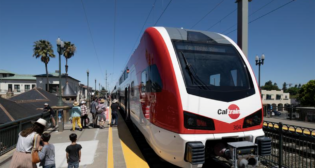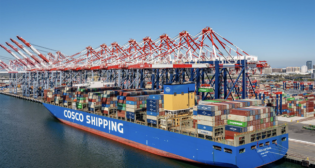
Signals lit for Lamphier and company
Written by Bruce E. Kelly, Contributing EditorThat facility, by the way, quietly celebrated its 10th anniversary this past September. Control points at East Downing and West Downing that govern train movements onto and off the fuel pad, are named in honor of Robert Downing, who served as President and COO of BNSF predecessor Burlington Northern. Before that, Downing was part of the merger steering committee and an Executive Vice President at BN predecessor Great Northern. Among his many achievements with GN and BN, Downing was instrumental in obtaining property at Hauser in the late 1960s, alongside what was then the Northern Pacific, for what would gradually develop into Hauser Yard: a crucial staging, refueling, and crew change point on BNSF’s busy Northern Corridor.
This year, another name has been added to the BNSF map, at a location nowhere near as “glamorous” as Hauser, but important enough to BNSF operations just the same. To get there, we must travel southwest from Hauser some 60-plus miles, and make a couple of historical stopovers along the way.
The Guide to the Northern Pacific Railroad and its Allied Lines – Official Edition 1886-7 described the rural outpost of Sprague, Wash., with a population of 1,500 at that time, as follows: “…headquarters for the Idaho Division of the Northern Pacific Railroad, and the location of the Division shops. The shops include a car shop, a machine shop, and a round-house, and employ a large number of workmen in car building, repairing locomotives, etc. Sprague has two hotels, seven general merchandise stores, two hardware stores, three agricultural implement stores, two drug stores, a brewery, a newspaper, and a bank, three churches, and a large public school building.”
There wasn’t a whole lot left of this town on the shrub steppe desert of eastern Washington after a fire in 1895 wiped out most of the railroad’s facilities and much of the town itself, population close to 3,000 then. Rather than rebuild at Sprague, NP chose to re-establish its division headquarters at the more rapidly growing city of Spokane Falls (now known simply as Spokane), some 40 miles to the northeast. Today, most folks who bother to exit Interstate 90 and drop into Sprague—population now hovering near 400—are either headed to Sprague Lake for a day of fishing, or have nearby work to perform on behalf of BNSF, or are merely stopping to get gas.
Back in December 1917, in the tiny town of Tyler, Wash., where the high desert meets pine forest roughly mid-way between Sprague and Spokane, George Kenneth Lamphier was born. His parents had come west from Oklahoma 15 years earlier. After schooling in Tyler and nearby Cheney, George Lamphier hired on with the NP as a section gang laborer based out of Sprague. He eventually became known as “the Super Gandy Dancer” for his “unsurpassed knowledge of the maintenance and laying of more than 25,000 miles of track” while holding assignments throughout the NP/BN system. Thirty of his 48 years in railroading were spent in Fargo, N.D., and St. Paul, Minn. George completed his career as BN’s Director of Track Maintenance in 1984, and he and his wife Juanita retired to Spokane. Following George’s death in December 2009, it was said that he always considered Sprague to be his hometown.
So it was more than fitting that the name Lamphier was given to the new 2.21-mile siding that BNSF crews laid just east of Sprague during 2014. The project was part of the roughly 20 miles of extended siding or second main track that BNSF added to its Lakeside Subdivision (Spokane-Pasco) this year. From an operating and engineering perspective, George Lamphier would be pleased with where his siding got placed: near the top of the first in a series of 1% grades that rise eastward from Sprague in stair-step fashion.
Gus Melonas, BNSF’s Director-Public Affairs in Seattle, says, “My dad Sam’s SP&S (BN predecessor Spokane, Portland & Seattle) district adjoined George’s district at Pasco. My dad was always impressed with George’s ability. He referred to George as the ‘Northwest’s Finest Gandy’ at merger time, and knew unquestionably that George would rise to a top leader level, managing track/engineering at BN.” After a 50-year career with the SP&S and BN track departments, Sam Melonas retired in 1986 from his position as Assistant Superintendent of Roadway Maintenance for the Seattle Region. (Sam’s father, incidentally, was the Track Foreman in charge of a section crew who took part in the original construction of the SP&S through the Columbia River Gorge in 1907-08.) Sam tells Railway Age, “I am pleased that George Lamphier will be recognized; he was a true railroader and a gentleman.”
From ties and ballast with a spike maul in hand up to the highest of company offices, people whose contributions have made a lasting difference to the rail industry deserve recognition in some shape or form, somewhere on the property. While much of the public is gazing at colorfully-lit Christmas trees and other holiday displays this season, train crews and wayside workers are ever-mindful of the signals that light the way past stations, junctions, and sidings whose place names have come from those who helped make each railroad what it is today.



